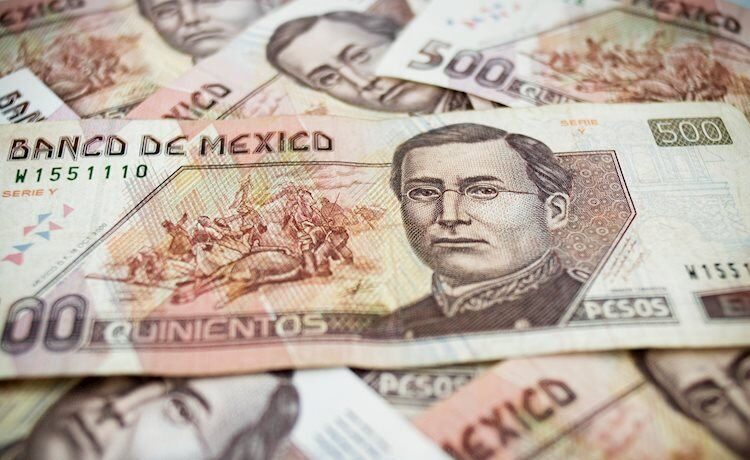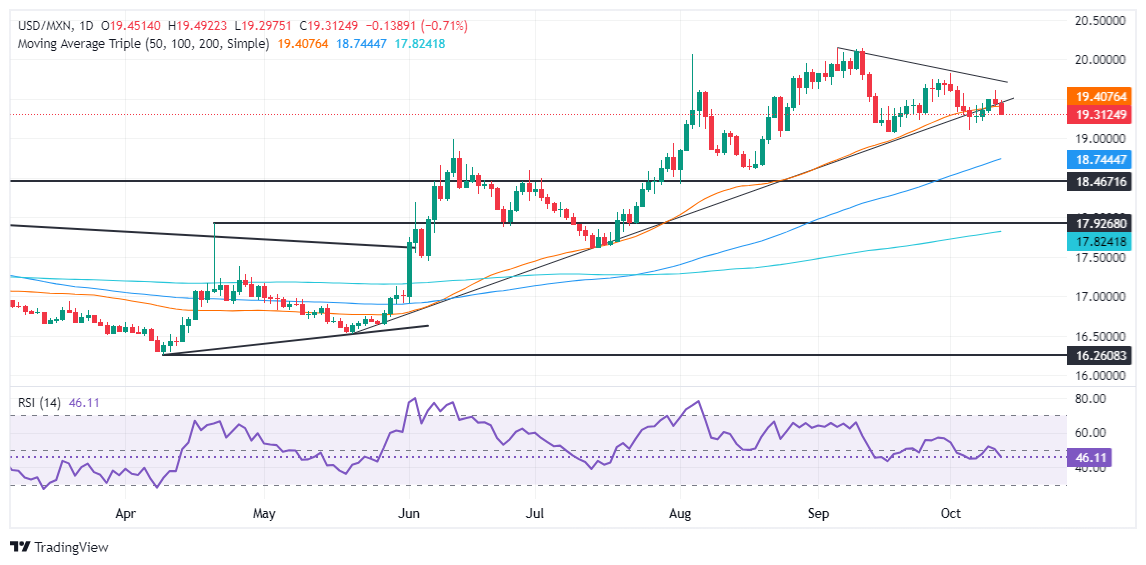- Mexican Peso strengthens for the second consecutive day as traders increase the odds of a 25 bps Fed rate cut to 85.9%.
- Banxico minutes confirm economic slowdown, reinforcing the view that less restrictive policy is needed as Mexican industrial production contracts.
- US Producer Price Index (PPI) data supports disinflation, while University of Michigan Consumer Sentiment weakens, and inflation expectations rise.
The Mexican Peso registers gains against the Greenback for the second consecutive day after hitting a low of 19.61 in early trading on Thursday. A tranche of economic data in the United States (US) reassured investors that the Federal Reserve (Fed) might lower borrowing costs at the November meeting, a headwind for the US Dollar. Therefore, the USD/MXN trades at 19.38, down 0.38%.
The US Bureau of Labor Statistics (BLS) revealed that prices paid by producers came in around estimates, indicating that the disinflation process is evolving. Lately, the University of Michigan (UoM) Consumer Sentiment showed signs of deterioration, while inflation expectations over the next year increased for the first time in five months.
The USD/MXN extended its losses as data from the CME FedWatch Tool showed that traders had increased the odds for a 25-basis-point rate cut to 85.9%, while the chances of the Fed keeping rates unchanged are 14.1%.
Across the south of the border, the Mexican economic docket revealed that Industrial Production contracted in monthly and annual figures, painting a gloomy economic outlook.
The minutes of the Bank of Mexico (Banxico) showed that the economy is undergoing a slowdown, losing some pace since the last quarter of 2023. This, along with the evolution of the disinflation process in Mexico, is one of the two reasons Banxico mentioned that policy needs to be less restrictive.
In the meantime, Chicago Fed President Austal Goolsbee crossed the newswires. He said he doesn’t see evidence of the economy overheating and that the central bank should focus on the dual mandate.
The US Dollar Index (DXY), which tracks the buck’s value against a basket of six peers, is virtually unchanged at 102.84, capping the USD/MXN advance on Friday.
Daily digest market movers: Mexican Peso bolstered due to soft US data
- Mexico’s Industrial Production in August plunged -0.5% MoM, missed the forecast, and July’s 0.2% increase. In the 12 months to August, production plummeted -0.9% below the 0.5% expansion awaited by the consensus.
- The Mexican Peso shrugged off the data and continued to rally due to the reduction of interest rate differentials between Mexico and the United States.
- According to Banxico’s poll, the central bank is projected to lower rates by 50 bps to 10% for the remainder of 2024. Meanwhile, the USD/MXN exchange rate will end near 19.69.
- Mexico’s economy is projected to grow by 1.45% in 2024, lower than August’s 1.57%.
- The September US Producer Price Index (PPI) came at 1.8% YoY, which was higher than the expected 1.6% but lower than August’s 1.9%. Core PPI rose by 2.8% YoY, above forecasts and September’s figures of 2.7% and 2.6%, respectively.
- PPI every month was 0%, lower than the estimated 0.1% and beneath August’s 0.2%. Core PPI ticked lower, as expected, to 0.2%, down from last month’s 0.3%.
- The UoM Consumer Sentiment deteriorated from 70.1 to 68.9, below expectations of 70.8. Inflation expectations for one year were revised from 2.7% to 2.9%.
- Friday’s slightly higher Consumer Price Index (CPI) and a soft US employment report could lead to additional Fed rate cuts.
- Data from the Chicago Board of Trade via the December fed funds rate futures contract shows investors estimate 49 bps of easing by the Fed toward the end of 2024.
USD/MXN technical outlook: Mexican Peso counter attacks as USD/MXN falls below 19.35
The USD/MXN uptrend remains in place, but it could consolidate within the 19.00-19.50 area. Momentum shows that sellers remain in charge as the Relative Strength Index (RSI) depicts.
In that outcome, if USD/MXN drops below the October 4 wing low of 19.10, the 19.00 figure will be exposed. Once broken, the next support would be the 100-day SMA at 18.64.
Conversely, if buyers stepped in and pushed the exchange rate above 19.50, this could pave the way for testing the October 1 daily high of 19.82, ahead of 20.00. Up next would be the YTD peak of 20.22.
Risk sentiment FAQs
In the world of financial jargon the two widely used terms “risk-on” and “risk off” refer to the level of risk that investors are willing to stomach during the period referenced. In a “risk-on” market, investors are optimistic about the future and more willing to buy risky assets. In a “risk-off” market investors start to ‘play it safe’ because they are worried about the future, and therefore buy less risky assets that are more certain of bringing a return, even if it is relatively modest.
Typically, during periods of “risk-on”, stock markets will rise, most commodities – except Gold – will also gain in value, since they benefit from a positive growth outlook. The currencies of nations that are heavy commodity exporters strengthen because of increased demand, and Cryptocurrencies rise. In a “risk-off” market, Bonds go up – especially major government Bonds – Gold shines, and safe-haven currencies such as the Japanese Yen, Swiss Franc and US Dollar all benefit.
The Australian Dollar (AUD), the Canadian Dollar (CAD), the New Zealand Dollar (NZD) and minor FX like the Ruble (RUB) and the South African Rand (ZAR), all tend to rise in markets that are “risk-on”. This is because the economies of these currencies are heavily reliant on commodity exports for growth, and commodities tend to rise in price during risk-on periods. This is because investors foresee greater demand for raw materials in the future due to heightened economic activity.
The major currencies that tend to rise during periods of “risk-off” are the US Dollar (USD), the Japanese Yen (JPY) and the Swiss Franc (CHF). The US Dollar, because it is the world’s reserve currency, and because in times of crisis investors buy US government debt, which is seen as safe because the largest economy in the world is unlikely to default. The Yen, from increased demand for Japanese government bonds, because a high proportion are held by domestic investors who are unlikely to dump them – even in a crisis. The Swiss Franc, because strict Swiss banking laws offer investors enhanced capital protection.


















